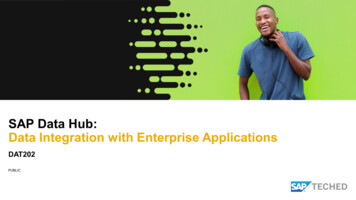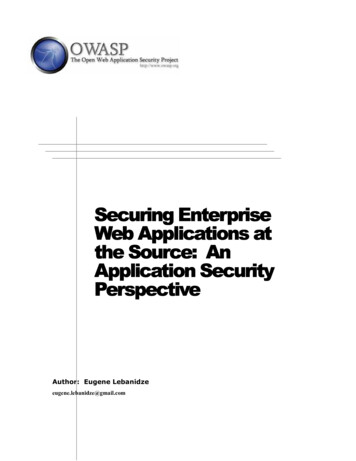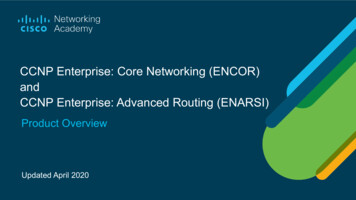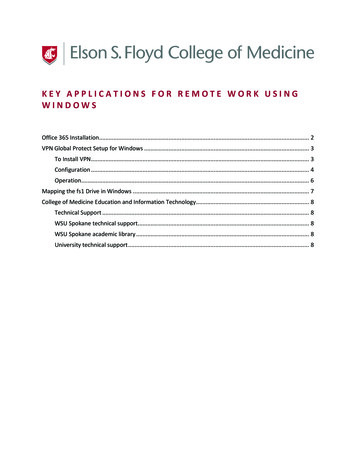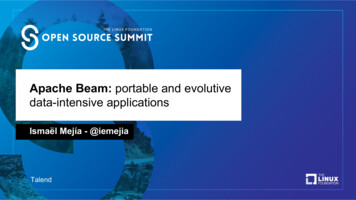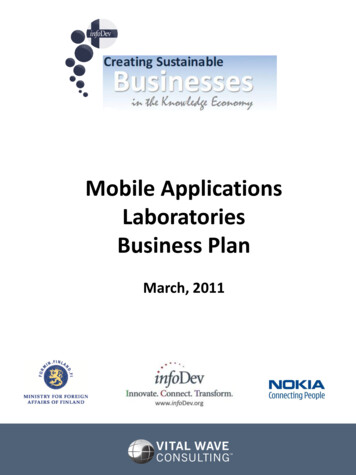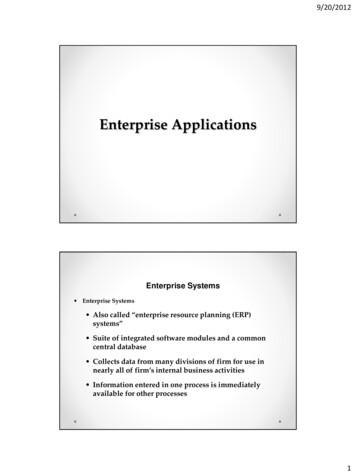
Transcription
9/20/2012Enterprise ApplicationsEnterprise Systems Enterprise Systems Also called “enterprise resource planning (ERP)systems” Suite of integrated software modules and a commoncentral database Collects data from many divisions of firm for use innearly all of firm’s internal business activities Information entered in one process is immediatelyavailable for other processes1
9/20/2012Enterprise Systems Enterprise Software Built around thousands of predefined business processesthat reflect best practices Finance/accounting: general ledger, accounts payable, and so on Human resources: personnel administration, payroll, and so on Manufacturing/production: purchasing, shipping, and so on Sales/marketing: order processing, billing, sales planning, and so on To implement, firms: Select functions of system they wish to use. Map business processes to software processes. Use software’s configuration tables for customizing.Enterprise SystemsHow Enterprise Systems WorkEnterprisesystems feature aset of integratedsoftwaremodules and acentral databasethat enables datato be shared bymany differentbusinessprocesses andfunctional areasthroughout theenterpriseFigure 8-12
9/20/2012Enterprise Systems Business value of enterprise systems Increase operational efficiency. Provide firm wide information to support decisionmaking. Enable rapid responses to customer requests forinformation or products. Include analytical tools to evaluate overallorganizational performance.Supply Chain Management SystemsThe Supply Chain Network of organizations and processes for: Procuring raw materials Transforming them into products Distributing the products Upstream supply chain: Firm’s suppliers, suppliers’ suppliers, processes for managingrelationships with them Downstream supply chain: Organizations and processes responsible for deliveringproducts to customers3
9/20/2012Supply Chain Management SystemsNike’s Supply ChainFigure 8-2This figure illustrates themajor entities in Nike’ssupply chain and the flowof information upstreamand downstream tocoordinate the activitiesinvolved in buying,making, and moving aproduct. Shown here is asimplified supply chain,with the upstream portionfocusing only on thesuppliers for sneakersand sneaker soles.Supply Chain Management SystemsInformation and Supply Chain Management Inefficiencies cut into a company’s operating costs Can waste up to 25 percent of operating expenses Just-in-time strategy: Components arrive as they are needed Finished goods shipped after leaving assembly line Safety stock Buffer for lack of flexibility in supply chain Bullwhip effect Information about product demand gets distorted as it passesfrom one entity to next across supply chain4
9/20/2012Supply Chain Management SystemsThe Bullwhip EffectInaccurateinformation cancause minorfluctuations indemand for aproduct to beamplified as onemoves further backin the supply chain.Minor fluctuations inretail sales for aproduct can createexcess inventory fordistributors,manufacturers, andsuppliers.Figure 8-3Supply Chain Management SystemsSupply Chain Management Software Supply chain planning systems Model existing supply chain. Demand planning. Optimize sourcing, manufacturing plans. Establish inventory levels. Identify transportation modes. Supply chain execution systems Manage flow of products through distribution centers andwarehouses.5
9/20/2012Supply Chain Management SystemsGlobal Supply Chains and the Internet Before Internet, supply chain coordination hampered by difficulties ofusing disparate internal supply chain systems. Enterprise systems supply some integration of internal supply chainprocesses but not designed to deal with external supply chain processes. Intranets and Extranets Intranets: to improve coordination among internal supplychain processes Extranets: to coordinate supply chain processes shared withtheir business partnersSupply Chain Management SystemsIntranets and Extranets for Supply Chain ManagementIntranets integrateinformation fromisolated businessprocesses within thefirm to help manage itsinternal supply chain.Access to these privateintranets can also beextended to authorizedsuppliers, distributors,logistics services, and,sometimes, to retailcustomers to improvecoordination of externalsupply chainprocesses.Figure 8-46
9/20/2012Customer Relationship Management SystemsInteractive Session: TechnologyProcter & Gamble Tries to Optimize Inventory Read the Interactive Session and then discuss the following questions: Why are larger supply chains more difficult to manage? List severalreasons. Why is supply chain management so important at a company suchas P&G? How did inventory optimization impact operations and decisionmaking at P&G? Why wouldn’t a small company derive as much benefit from multiechelon inventory optimization?Supply Chain Management SystemsGlobal Supply Chains and the Internet Global supply chain issues: Global supply chains typically span greater geographicdistances and time differences. More complex pricing issues (local taxes, transportation,etc.). Foreign government regulations. Internet helps companies manage many aspects of global supplychains. Sourcing, transportation, communications, international finance7
9/20/2012Supply Chain Management SystemsGlobal Supply Chains and the Internet Supply chain management systems Push-based model (build-to-stock) Schedules based on best guesses of demand Pull-based model (demand-driven) Customer orders trigger events in supply chain Sequential supply chains Information and materials flow sequentially from company tocompany Concurrent supply chains Information flows in many directions simultaneously amongmembers of a supply chain networkSupply Chain Management SystemsPush- Versus Pull-Based Supply Chain ModelsThe differencebetween pushand pull-basedmodels issummarized bythe slogan“Make what wesell, not sellwhat we make.”Figure 8-58
9/20/2012Supply Chain Management SystemsBusiness Value of Supply Chain Management Systems Match supply to demand. Reduce inventory levels. Improve delivery service. Speed product time to market. Use assets more effectively. Reduced supply chain costs lead to increased profitability. Increase sales.Supply Chain Management SystemsThe Future Internet-Driven Supply ChainThe future Internetdriven supply chainoperates like a digitallogistics nervoussystem. It providesmultidirectionalcommunicationamong firms,networks of firms,and e-marketplacesso that entirenetworks of supplychain partners canimmediately adjustinventories, orders,and capacities.Figure 8-69
9/20/2012Customer Relationship Management SystemsWhat Is Customer Relationship Management? Knowing the customer In large businesses, too many customers and too many wayscustomers interact with firm Customer relationship management (CRM) systems Capture and integrate customer data from all over theorganization. Consolidate and analyze customer data. Distribute customer information to various systems andcustomer touch points across enterprise. Provide single enterprise view of customers.Customer Relationship Management SystemsCustomer Relationship Management (CRM)CRM systems examinecustomers from amultifacetedperspective. Thesesystems use a set ofintegrated applicationsto address all aspects ofthe customerrelationship, includingcustomer service, sales,and marketing.Figure 8-710
9/20/2012Customer Relationship Management SystemsCRM Software CRM packages range from niche tools to large-scale enterpriseapplications. More comprehensive have modules for: Partner relationship management (PRM) Integrating lead generation, pricing, promotions, orderconfigurations, and availability Tools to assess partners’ performances Employee relationship management (ERM) E.g., setting objectives, employee performance management,performance-based compensation, employee trainingCustomer Relationship Management SystemsCRM Software CRM packages typically include tools for: Sales force automation (SFA) E.g., sales prospect and contact information, and salesquote generation capabilities Customer service E.g., assigning and managing customer service requests;Web-based self-service capabilities Marketing E.g., capturing prospect and customer data, schedulingand tracking direct-marketing mailings or e-mail11
9/20/2012Customer Relationship Management SystemsHow CRM Systems Support MarketingCustomer relationshipmanagement softwareprovides a single pointfor users to manage andevaluate marketingcampaigns acrossmultiple channels,including e-mail, directmail, telephone, theWeb, and wirelessmessages.Figure 8-8Enterprise SystemsInteractive Session: OrganizationsCRM Helps Chase Card Services Manage Customer Calls Read the Interactive Session and then discuss the following questions: Why is the call center so important for Chase Card Services?How could Chase’s call centers help it improve relationshipswith customers? Describe the problem at Chase call centers. Whatmanagement, organization, or technology factors contributedto the problem? How did using Enkata improve operational performance anddecision making?12
9/20/2012Customer Relationship Management SystemsCRM Software CapabilitiesThe major CRM softwareproducts supportbusiness processes insales, service, andmarketing, integratingcustomer informationfrom many differentsources. Included aresupport for both theoperational andanalytical aspects ofCRM.Figure 8-9Customer Relationship Management SystemsCustomer Loyalty Management Process MapFigure 8-10This process map shows how a best practice for promoting customerloyalty through customer service would be modeled by customerrelationship management software. The CRM software helps firms identifyhigh-value customers for preferential treatment.13
9/20/2012Customer Relationship Management SystemsOperational and Analytical CRM Operational CRM: Customer-facing applications such as sales force automation, callcenter and customer service support, and marketing automation Analytical CRM: Analyzes customer data output from operational CRM applications Based on data warehouses populated by operationalCRM systems and customer touch points Customer lifetime value (CLTV)Customer Relationship Management SystemsAnalytical CRM Data WarehouseAnalytical CRMuses a customerdata warehouseand tools toanalyze customerdata collected fromthe firm’scustomer touchpoints and fromother sources.Figure 8-1114
9/20/2012Customer Relationship Management SystemsBusiness Value of Customer Relationship Management Business benefits: Increased customer satisfaction Reduced direct-marketing costs More effective marketing Lower costs for customer acquisition/retention Increased sales revenue Churn rate: Number of customers who stop using or purchasing productsor services from a company Indicator of growth or decline of firm’s customer baseEnterprise Applications: New Opportunities and ChallengesEnterprise Application Challenges Highly expensive to purchase and implement enterprise applications—total cost may be four to five times the price of software Technology changes Business process changes Organizational changes Switching costs, dependence on software vendors Data standardization, management, cleansing15
9/20/2012Enterprise Applications: New Opportunities and ChallengesExtending Enterprise Software To bring greater value from enterprise applications Enterprise solutions/suites: make applications more flexible, Webenabled, integrated with other systems Service platform: integrates multiple applications to deliver aseamless experience for all parties Order-to-cash process Portal softwareEnterprise Applications: New Opportunities and ChallengesOrder-to-Cash ServiceOrder-to-cash is acomposite processthat integrates datafrom individualenterprise systemsand legacy financialapplications. Theprocess must bemodeled andtranslated into asoftware system usingapplication integrationtools.Figure 8-1216
Tools to assess partners’ performances Employee relationship management (ERM) E.g., setting objectives, employee performance management, performance-based compensation, employee training Customer Relationship Management Systems CRM Software CRM packages typically include tools for: Sales force automation (SFA) E.g., sales prospect and contact information, and salesFile Size: 1MBPage Count: 16

